#supply chain software features
Explore tagged Tumblr posts
Text
Learn about the most critical features for modern supply chain software, including real-time tracking, AI integration, and predictive analytics to streamline logistics operations.
#supply chain software features#essential supply chain tools#supply chain management#logistics software must-haves#SCM technology features.
0 notes
Text
In today’s digital-first world, businesses are under immense pressure to optimize operations, reduce costs, and improve partner communication. EDI Software Solutions have emerged as the backbone of digital transformation, enabling secure and standardized data exchange across systems and partners through electronic data interchange. From healthcare EDI to supply chain automation, the scope and relevance of EDI systems are expanding fast.However, not all EDI solutions are created equal. The right EDI tool can make a monumental difference in efficiency, compliance, and collaboration. Whether you're integrating with EMR software solutions, EHR software solutions, or simply looking to enhance B2B integration, this guide outlines the top 10 must-have features in a modern EDI software solution.
#EDI Software Solutions#EDI Integration#Electronic Data Interchange#EMR Software Solutions#EHR Software Solutions#Healthcare EDI#B2B Integration#Supply Chain Automation#EDI Features#EDI Tools#Custom Healthcare Software#HL7 Integration#X12 Standard#API Integration#Healthcare IT Solutions#Digital Transformation#Custom Software Development#Data Exchange Solutions#Cloud-Based EDI#EDI for Healthcare
0 notes
Text
Transportation Management System Features
Transportation Management System Features are pivotal for efficient logistics. Route optimization, cost reduction, and real-time tracking define TMS capabilities. Seamless integration with other systems ensures data flow, aiding decision-making. Automated documentation simplifies compliance. Robust analytics tools offer strategic insights. TMS enhances supply chain visibility and control, optimizing transportation processes through its comprehensive features.
1 note
·
View note
Text
In March 2007, Google’s then senior executive in charge of acquisitions, David Drummond, emailed the company’s board of directors a case for buying DoubleClick. It was an obscure software developer that helped websites sell ads. But it had about 60 percent market share and could accelerate Google’s growth while keeping rivals at bay. A “Microsoft-owned DoubleClick represents a major competitive threat,” court papers show Drummond writing.
Three weeks later, on Friday the 13th, Google announced the acquisition of DoubleClick for $3.1 billion. The US Department of Justice and 17 states including California and Colorado now allege that the day marked the beginning of Google’s unchecked dominance in online ads—and all the trouble that comes with it.
The government contends that controlling DoubleClick enabled Google to corner websites into doing business with its other services. That has resulted in Google allegedly monopolizing three big links of a vital digital advertising supply chain, which funnels over $12 billion in annual revenue to websites and apps in the US alone.
It’s a big amount. But a government expert estimates in court filings that if Google were not allegedly destroying its competition illegally, those publishers would be receiving up to an additional hundreds of millions of dollars each year. Starved of that potential funding, “publishers are pushed to put more ads on their websites, to put more content behind costly paywalls, or to cease business altogether,” the government alleges. It all adds up to a subpar experience on the web for consumers, Colorado attorney general Phil Weiser says.
“Google is able to extract hiked-up costs, and those are passed on to consumers,” he alleges. “The overall outcome we want is for consumers to have more access to content supported by advertising revenue and for people who are seeking advertising not to have to pay inflated costs.”
Google disputes the accusations.
Starting today, both sides’ arguments will be put to the test in what’s expected to be a weekslong trial before US district judge Leonie Brinkema in Alexandria, Virginia. The government wants her to find that Google has violated federal antitrust law and then issue orders that restore competition. In a best-case scenario, according to several Google critics and experts in online ads who spoke with WIRED, internet users could find themselves more pleasantly informed and entertained.
It could take years for the ad market to shake out, says Adam Heimlich, a longtime digital ad executive who’s extensively researched Google. But over time, fresh competition could lower supply chain fees and increase innovation. That would drive “better monetization of websites and better quality of websites,” says Heimlich, who now runs AI software developer Chalice Custom Algorithms.
Tim Vanderhook, CEO of ad-buying software developer Viant Technology, which both competes and partners with Google, believes that consumers would encounter a greater variety of ads, fewer creepy ads, and pages less cluttered with ads. “A substantially improved browsing experience,” he says.
Of course, all depends on the outcome of the case. Over the past year, Google lost its two other antitrust trials—concerning illegal search and mobile app store monopolies. Though the verdicts are under appeal, they’ve made the company’s critics optimistic about the ad tech trial.
Google argues that it faces fierce competition from Meta, Amazon, Microsoft, and others. It further contends that customers benefited from each of the acquisitions, contracts, and features that the government is challenging. “Google has designed a set of products that work efficiently with each other and attract a valuable customer base,” the company’s attorneys wrote in a 359-page rebuttal.
For years, Google publicly has maintained that its ad tech projects wouldn’t harm clients or competition. “We will be able to help publishers and advertisers generate more revenue, which will fuel the creation of even more rich and diverse content on the internet,” Drummond testified in 2007 to US senators concerned about the DoubleClick deal’s impact on competition and privacy. US antitrust regulators at the time cleared the purchase. But at least one of them, in hindsight, has said he should have blocked it.
Deep Control
The Justice Department alleges that acquiring DoubleClick gave Google “a pool of captive publishers that now had fewer alternatives and faced substantial switching costs associated with changing to another publisher ad server.” The global market share of Google’s tool for publishers is now 91 percent, according to court papers. The company holds similar control over ad exchanges that broker deals (around 70 percent) and tools used by advertisers (85 percent), the court filings say.
Google’s dominance, the government argues, has “impaired the ability of publishers and advertisers to choose the ad tech tools they would prefer to use and diminished the number and quality of viable options available to them.”
The government alleges that Google staff spoke internally about how they have been earning an unfair portion of what advertisers spend on advertising, to the tune of over a third of every $1 spent in some cases.
Some of Google’s competitors want the tech giant to be broken up into multiple independent companies, so each of its advertising services competes on its own merits without the benefit of one pumping up another. The rivals also support rules that would bar Google from preferencing its own services. “What all in the industry are looking for is fair competition,” Viant’s Vanderhook says.
If Google ad tech alternatives win more business, not everyone is so sure that the users will notice a difference. “We’re talking about moving from the NYSE to Nasdaq,” Ari Paparo, a former DoubleClick and Google executive who now runs the media company Marketecture, tells WIRED. The technology behind the scenes may shift, but the experience for investors—or in this case, internet surfers—doesn’t.
Some advertising experts predict that if Google is broken up, users’ experiences would get even worse. Andrey Meshkov, chief technology officer of ad-block developer AdGuard, expects increasingly invasive tracking as competition intensifies. Products also may cost more because companies need to not only hire additional help to run ads but also buy more ads to achieve the same goals. “So the ad clutter is going to get worse,” Beth Egan, an ad executive turned Syracuse University associate professor, told reporters in a recent call arranged by a Google-funded advocacy group.
But Dina Srinivasan, a former ad executive who as an antitrust scholar wrote a Stanford Technology Law Review paper on Google’s dominance, says advertisers would end up paying lower fees, and the savings would be passed on to their customers. That future would mark an end to the spell Google allegedly cast with its DoubleClick deal. And it could happen even if Google wins in Virginia. A trial in a similar lawsuit filed by Texas, 15 other states, and Puerto Rico is scheduled for March.
31 notes
·
View notes
Text
Why are headlights so expensive for cars?
The high cost of modern car headlights is driven by a convergence of advanced technology, complex design, stringent regulations, and market factors. Here's a breakdown of the key reasons:
Advanced Technology & Complexity:
LED/Laser/Matrix Systems: Modern headlights use multi-element LED arrays, adaptive projectors, laser elements (on high-end models), or matrix/pixel technology that individually dims segments of the beam. This requires sophisticated control units, sensors, and wiring.
Adaptive Functionality: Features like auto-leveling, cornering beams, glare-free high beams, and dynamic light projections require motors, cameras, complex software, and extra wiring harnesses.
Integrated Components: Headlights now house DRLs (Daytime Running Lights), turn signals, position lights, and often front-facing sensors (radar/camera for ADAS) all in one sealed unit, driving up complexity.
Precision Engineering & Materials:
Optical Precision: Lenses and reflectors are molded with extreme precision to meet strict beam pattern regulations and avoid glare. Molds for these optics are incredibly expensive to design and manufacture.
Materials: High-performance polycarbonate lenses resist yellowing and cracking, while complex aluminum or magnesium heat sinks efficiently dissipate heat from powerful LEDs/Lasers. Seals must be perfect to prevent moisture and corrosion. Internal reflectors use specialized coatings.
Durability Requirements: Headlights must withstand extreme temperatures, UV radiation, road debris impacts, vibrations, and chemical exposure (car washes, road salt) for the vehicle's lifespan. This requires high-grade materials and construction.
Regulation & Testing Overhead:
Global Standards: Headlights must comply with strict global regulations (SAE, ECE, etc.) regarding beam pattern, intensity, cutoff sharpness, and aiming. Developing, testing, and certifying each headlight design for different markets adds significant cost.
Complex Testing: Extensive lab and road testing is required to ensure compliance, durability, and performance in all conditions, adding R&D costs.
Design and Manufacturing Integration:
Styling Demands: Headlights are critical styling elements. Aggressive shapes, intricate lighting signatures ("light jewelry"), and seamless integration with body panels require complex, unique housings for each model.
Custom Manufacturing: Headlights are model-specific (often even trim-level specific). Low-volume production runs compared to simple bulbs mean costs aren't spread over millions of identical units. Assembly involves delicate electronics and precise calibration.
Module Design: Modern headlights are typically sold as sealed assemblies ("modules"). If anything fails inside (LED chip, driver, ballast, motor, wiring), you often have to replace the entire 800+ unit, not a 10 bulb.
Supply Chain & Market Factors:
OEM vs. Aftermarket: Dealers charge high prices for genuine OEM parts, covering their overhead and profit margins. While quality aftermarket options exist (often significantly cheaper), OE parts command a premium.
Insurance Influence: Since insurance often pays for replacements after collisions (which frequently damage headlights), manufacturers have less pressure to minimize headlight costs compared to components owners pay for directly.
Low Price Elasticity: Headlights are essential safety items. Consumers need them to drive legally and safely, reducing the incentive for manufacturers/dealers to compete heavily on price for replacements.
Supplier Profit: Tier-1 suppliers (like Valeo, Bosch, Magna, Koito) design and build these complex units and need to recoup their substantial R&D and tooling investments per unit sold to the automaker.
Labor Cost (Hidden): Installation is often complex, requiring bumper/fender removal and sometimes electronic calibration/reprogramming. While the part cost is high, labor adds significantly to the total replacement expense perceived by the owner.
Comparison to Older Designs:
Simple Halogen Reflectors: Used cheap bulbs (10-50), simple reflectors, and a basic lens. Easy to manufacture replaceable bulbs. Entire assembly replacement was relatively inexpensive (100-300).
HID Projectors: Introduced cost via ballasts and specialized bulbs (50-150 per bulb), but the projectors and housings were less complex than modern LED units. Assemblies cost more than halogens but less than LEDs.
Modern LED/Adaptive Units: Represent a quantum leap in technology, integration, and complexity, hence the price jump.
In essence: You're paying for high-tech electronics, extreme precision optics, complex software integration, advanced materials built for durability, significant R&D/testing/regulatory costs, custom low-volume manufacturing of a styling-critical safety component, and market dynamics where insurers often foot the bill. It's a far cry from swapping out a simple bulb in a basic reflector housing.

#led lights#car lights#led car light#youtube#led auto light#led headlights#led light#led headlight bulbs#ledlighting#young artist#led light bulbs#led strip lights#car rental#electric cars#classic cars#car#cars#truck#porsche#suv#lamborghini#sabrina carpenter#bmw#carlos sainz#autonomous vehicle headlights#overtake another vehicle#older vehicles#vehicle#auto mode#automobiles
3 notes
·
View notes
Text
How Small and Mid-Sized Engineering Firms Can Benefit from ERP
In today’s competitive business landscape, manufacturers and engineering companies in India are under constant pressure to improve efficiency, reduce costs, and enhance productivity. The adoption of ERP for manufacturing companies in India has become more than just a trend—it is a necessity for survival and growth. Manufacturing ERP software in India is specifically designed to address the unique challenges faced by the industry, offering seamless integration, automation, and data-driven decision-making capabilities.

If you are an engineering or manufacturing business looking to streamline your operations, this blog will help you understand why ERP software for engineering companies in India is essential and how choosing the best ERP for the engineering industry can revolutionize your operations.
Why ERP is Essential for Manufacturing and Engineering Companies
1. Streamlining Operations and Enhancing Efficiency
One of the biggest challenges faced by manufacturing and engineering companies is managing various processes such as inventory, procurement, production, and distribution. Manufacturing ERP software in India centralizes data, enabling real-time monitoring and control over every aspect of the business. This eliminates redundant tasks, reduces manual errors, and improves efficiency.
2. Improved Supply Chain Management
A well-integrated ERP system ensures smooth coordination with suppliers, vendors, and distributors. With ERP for manufacturing companies in India, businesses can track raw materials, monitor supplier performance, and optimize procurement processes, reducing delays and ensuring a seamless supply chain.
3. Enhanced Data-Driven Decision Making
With access to real-time data analytics and comprehensive reporting, ERP software for engineering companies in India empowers businesses to make informed decisions. Managers can analyze production trends, forecast demand, and identify areas for improvement, leading to better business outcomes.
4. Cost Reduction and Higher Profitability
Automation of processes helps in minimizing waste, reducing operational costs, and increasing profitability. The best ERP for the engineering industry ensures resource optimization by tracking inventory levels, reducing excess stock, and eliminating inefficiencies in production planning.
5. Compliance and Quality Control
Manufacturers must adhere to strict industry standards and regulatory requirements. Manufacturing ERP software in India helps in maintaining compliance by providing documentation, audit trails, and quality control measures, ensuring that all products meet industry regulations.
Key Features of the Best ERP for Engineering Industry
Choosing the right ERP solution is crucial for achieving maximum benefits. Here are some key features to look for in an ERP software for engineering companies in India:
Comprehensive Production Planning & Control – Ensures seamless coordination between different production units.
Inventory & Material Management – Tracks stock levels, raw materials, and procurement processes efficiently.
Financial Management – Integrates accounting, payroll, and financial reporting for better fiscal control.
Supply Chain Management – Enhances supplier relationships and improves procurement efficiency.
Customer Relationship Management (CRM) – Manages customer interactions, sales pipelines, and service requests.
Business Intelligence & Reporting – Provides real-time insights for strategic decision-making.
Scalability & Customization – Adapts to the growing needs of your business with modular functionalities.
Top ERP Software Providers in India
India is home to some of the top ERP software providers, offering advanced solutions for engineering and manufacturing businesses. Companies like Shantitechnology (STERP) have emerged as leaders in providing industry-specific ERP solutions that cater to the unique requirements of manufacturing and engineering firms.
Why Choose STERP?
STERP is one of the top ERP software providers in India, offering customized ERP solutions specifically designed for the engineering and manufacturing industries. Here is why STERP stands out:
Industry-Specific Solutions – Tailored to meet the challenges of the manufacturing and engineering sectors.
Cloud & On-Premise Options – Flexible deployment models to suit different business needs.
User-Friendly Interface – Easy to use, with intuitive dashboards and real-time analytics.
Excellent Customer Support – Dedicated support teams for implementation and ongoing assistance.
Scalable Solutions – Designed to grow with your business, ensuring long-term usability and return on investment.
How to Implement ERP for Maximum Success
Step 1: Assess Business Needs
Understand your business requirements and identify key areas that need improvement. Choose a solution that aligns with your industry needs.
Step 2: Choose the Right ERP Software
Selecting the best ERP for the engineering industry involves comparing features, scalability, pricing, and vendor support.
Step 3: Customization & Integration
Ensure that the ERP system integrates seamlessly with your existing tools and is customizable to fit your unique business processes.
Step 4: Training & Support
Invest in training programs to ensure that your team is comfortable using the new system. Opt for a provider that offers continuous support and upgrades.
Step 5: Monitor & Optimize
Post-implementation, continuously monitor the system’s performance, gather feedback, and make necessary optimizations to enhance efficiency.
Future Trends in ERP for Manufacturing and Engineering
The ERP landscape is evolving rapidly, with emerging trends shaping the future of ERP for manufacturing companies in India. Some key trends to watch include:
AI & Machine Learning Integration – Automating predictive maintenance and process optimization.
Cloud-Based ERP Solutions – Offering flexibility, remote accessibility, and cost savings.
IoT-Enabled ERP – Enhancing real-time tracking of production and inventory.
Mobile ERP – Allowing on-the-go access for better decision-making.
Blockchain for Supply Chain Management – Ensuring transparency and security in transactions.
Conclusion
Investing in ERP software for engineering companies in India is no longer an option—it is a necessity for businesses looking to stay ahead in the competitive market. Whether you are a small manufacturer or a large-scale engineering firm, having the best ERP for the engineering industry can drive efficiency, improve decision-making, and enhance overall profitability.
With industry leaders like Shantitechnology (STERP) offering cutting-edge solutions, businesses can achieve digital transformation effortlessly. As one of the top ERP software providers in India, STERP continues to empower manufacturing and engineering companies with tailored ERP solutions.
Are you ready to revolutionize your business with ERP? Contact STERP today and take the first step towards seamless automation and unmatched efficiency!
#ERP software for engineering companies#Engineering ERP Software Company#ERP solution providers#ERP software companies#ERP software for engineering companies in India#Best ERP for engineering industry#India#Gujarat#Maharashtra
4 notes
·
View notes
Text
The Road Ahead – Navigating the Future of the Automotive Industry
🌍 Market Overview
The Global automotive industry Market Size is evolving rapidly, driven by technological advancements, sustainability initiatives, and changing consumer preferences. Automakers are embracing electric vehicles (EVs), autonomous technology, and digital transformation to stay ahead.
Download a Free Sample : https://rb.gy/iwh4in
📈 Growth Drivers
✅ Electrification – Rise in EV adoption due to sustainability goals and government incentives. ✅ Autonomous Vehicles – Investments in self-driving technology from major players like Tesla, Waymo, and GM. ✅ Connectivity & IoT – Smart features, in-car AI, and enhanced safety tech. ✅ Urbanization & Mobility Services – Growth of ride-sharing and subscription-based vehicle models.
⚠️ Key Challenges & Factors
🚧 Chip Shortages – Semiconductor supply chain disruptions affecting production. 🚧 Regulatory Hurdles – Stricter emissions policies worldwide. 🚧 Consumer Preferences – Shift towards SUVs and electric mobility. 🚧 Raw Material Costs – Fluctuations in lithium, nickel, and other EV battery components.
🔥 Emerging Trends
🔹 EV Market Boom – Tesla, Rivian, and legacy automakers expanding electric fleets. 🔹 Hydrogen Fuel Cell Tech – Toyota & Hyundai leading innovations. 🔹 Sustainable Manufacturing – Recycling initiatives & carbon-neutral plants. 🔹 Software-Defined Vehicles – Over-the-air (OTA) updates & AI-driven enhancements.
Related Urls :
https://www.sphericalinsights.com/reports/automotive-blockchain-market https://www.sphericalinsights.com/reports/china-halal-logistics-market
#AutomotiveIndustry 🚗 |#EVRevolution ⚡ |#CarTrends 🚘 |#FutureOfMobility 🌍 |#AutoTech 🔧 |#ElectricVehicles 🔋 |#AutonomousCars 🤖 |#GreenMobility 🌱 |#CarManufacturing 🏭 |#SmartCars 📡 |#SustainableTransport 🚀 |#AutoInnovation 🔥 |#NextGenVehicles 🚙 |#AutomotiveMarket 📈 |#MobilitySolutions 🚦
2 notes
·
View notes
Text
How-To IT
Topic: Core areas of IT
1. Hardware
• Computers (Desktops, Laptops, Workstations)
• Servers and Data Centers
• Networking Devices (Routers, Switches, Modems)
• Storage Devices (HDDs, SSDs, NAS)
• Peripheral Devices (Printers, Scanners, Monitors)
2. Software
• Operating Systems (Windows, Linux, macOS)
• Application Software (Office Suites, ERP, CRM)
• Development Software (IDEs, Code Libraries, APIs)
• Middleware (Integration Tools)
• Security Software (Antivirus, Firewalls, SIEM)
3. Networking and Telecommunications
• LAN/WAN Infrastructure
• Wireless Networking (Wi-Fi, 5G)
• VPNs (Virtual Private Networks)
• Communication Systems (VoIP, Email Servers)
• Internet Services
4. Data Management
• Databases (SQL, NoSQL)
• Data Warehousing
• Big Data Technologies (Hadoop, Spark)
• Backup and Recovery Systems
• Data Integration Tools
5. Cybersecurity
• Network Security
• Endpoint Protection
• Identity and Access Management (IAM)
• Threat Detection and Incident Response
• Encryption and Data Privacy
6. Software Development
• Front-End Development (UI/UX Design)
• Back-End Development
• DevOps and CI/CD Pipelines
• Mobile App Development
• Cloud-Native Development
7. Cloud Computing
• Infrastructure as a Service (IaaS)
• Platform as a Service (PaaS)
• Software as a Service (SaaS)
• Serverless Computing
• Cloud Storage and Management
8. IT Support and Services
• Help Desk Support
• IT Service Management (ITSM)
• System Administration
• Hardware and Software Troubleshooting
• End-User Training
9. Artificial Intelligence and Machine Learning
• AI Algorithms and Frameworks
• Natural Language Processing (NLP)
• Computer Vision
• Robotics
• Predictive Analytics
10. Business Intelligence and Analytics
• Reporting Tools (Tableau, Power BI)
• Data Visualization
• Business Analytics Platforms
• Predictive Modeling
11. Internet of Things (IoT)
• IoT Devices and Sensors
• IoT Platforms
• Edge Computing
• Smart Systems (Homes, Cities, Vehicles)
12. Enterprise Systems
• Enterprise Resource Planning (ERP)
• Customer Relationship Management (CRM)
• Human Resource Management Systems (HRMS)
• Supply Chain Management Systems
13. IT Governance and Compliance
• ITIL (Information Technology Infrastructure Library)
• COBIT (Control Objectives for Information Technologies)
• ISO/IEC Standards
• Regulatory Compliance (GDPR, HIPAA, SOX)
14. Emerging Technologies
• Blockchain
• Quantum Computing
• Augmented Reality (AR) and Virtual Reality (VR)
• 3D Printing
• Digital Twins
15. IT Project Management
• Agile, Scrum, and Kanban
• Waterfall Methodology
• Resource Allocation
• Risk Management
16. IT Infrastructure
• Data Centers
• Virtualization (VMware, Hyper-V)
• Disaster Recovery Planning
• Load Balancing
17. IT Education and Certifications
• Vendor Certifications (Microsoft, Cisco, AWS)
• Training and Development Programs
• Online Learning Platforms
18. IT Operations and Monitoring
• Performance Monitoring (APM, Network Monitoring)
• IT Asset Management
• Event and Incident Management
19. Software Testing
• Manual Testing: Human testers evaluate software by executing test cases without using automation tools.
• Automated Testing: Use of testing tools (e.g., Selenium, JUnit) to run automated scripts and check software behavior.
• Functional Testing: Validating that the software performs its intended functions.
• Non-Functional Testing: Assessing non-functional aspects such as performance, usability, and security.
• Unit Testing: Testing individual components or units of code for correctness.
• Integration Testing: Ensuring that different modules or systems work together as expected.
• System Testing: Verifying the complete software system’s behavior against requirements.
• Acceptance Testing: Conducting tests to confirm that the software meets business requirements (including UAT - User Acceptance Testing).
• Regression Testing: Ensuring that new changes or features do not negatively affect existing functionalities.
• Performance Testing: Testing software performance under various conditions (load, stress, scalability).
• Security Testing: Identifying vulnerabilities and assessing the software’s ability to protect data.
• Compatibility Testing: Ensuring the software works on different operating systems, browsers, or devices.
• Continuous Testing: Integrating testing into the development lifecycle to provide quick feedback and minimize bugs.
• Test Automation Frameworks: Tools and structures used to automate testing processes (e.g., TestNG, Appium).
19. VoIP (Voice over IP)
VoIP Protocols & Standards
• SIP (Session Initiation Protocol)
• H.323
• RTP (Real-Time Transport Protocol)
• MGCP (Media Gateway Control Protocol)
VoIP Hardware
• IP Phones (Desk Phones, Mobile Clients)
• VoIP Gateways
• Analog Telephone Adapters (ATAs)
• VoIP Servers
• Network Switches/ Routers for VoIP
VoIP Software
• Softphones (e.g., Zoiper, X-Lite)
• PBX (Private Branch Exchange) Systems
• VoIP Management Software
• Call Center Solutions (e.g., Asterisk, 3CX)
VoIP Network Infrastructure
• Quality of Service (QoS) Configuration
• VPNs (Virtual Private Networks) for VoIP
• VoIP Traffic Shaping & Bandwidth Management
• Firewall and Security Configurations for VoIP
• Network Monitoring & Optimization Tools
VoIP Security
• Encryption (SRTP, TLS)
• Authentication and Authorization
• Firewall & Intrusion Detection Systems
• VoIP Fraud DetectionVoIP Providers
• Hosted VoIP Services (e.g., RingCentral, Vonage)
• SIP Trunking Providers
• PBX Hosting & Managed Services
VoIP Quality and Testing
• Call Quality Monitoring
• Latency, Jitter, and Packet Loss Testing
• VoIP Performance Metrics and Reporting Tools
• User Acceptance Testing (UAT) for VoIP Systems
Integration with Other Systems
• CRM Integration (e.g., Salesforce with VoIP)
• Unified Communications (UC) Solutions
• Contact Center Integration
• Email, Chat, and Video Communication Integration
2 notes
·
View notes
Text
STON.fi: The Future of Decentralized Trading on TON Blockchain

In a world where control over your finances is more important than ever, STON.fi steps up as the leading decentralized exchange (DEX) on The Open Network (TON) blockchain. It’s not just about trading; it’s about empowering you to take full control of your digital assets. Let’s break it down into simple, relatable terms.
What Makes STON.fi Special
Have you ever traded crypto and worried about losing access to your funds? Or felt frustrated by slow, costly transactions? STON.fi solves these problems by letting you trade directly without intermediaries. You control your private keys, ensuring your funds are always safe.
With advanced tech like Request for Quote (RFQ) protocols and Hashed Timelock Contracts (HTLC), STON.fi guarantees quick, transparent, and secure transactions. You’re either getting exactly what you agreed on, or the trade doesn’t happen. No middlemen, no surprises.
Trade Made Simple: Swapping TON-Based Tokens
Imagine swapping one crypto for another without the hassle of converting to fiat first. That’s what STON.fi offers. You can trade $TON for other TON-based tokens with ease, all while enjoying low fees (just 0.3% per trade).
Here’s the kicker: when you trade, part of the fee goes back to liquidity providers, meaning the community benefits as a whole.
Earning Opportunities on STON.fi
Who doesn’t love making their money work for them? STON.fi offers several ways to earn:
1. Provide Liquidity: By adding your tokens to liquidity pools, you earn rewards based on your contribution.
2. Farming: Stake LP tokens to get even more rewards from specific pools.
3. STONbassador Program: Promote STON.fi and earn for helping the platform grow.
Meet the $STON Token
Think of $STON as the backbone of the STON.fi ecosystem. It’s used for governance, gas fees, and transactions. Plus, it has a limited supply of 100 million, making it a valuable asset over time.
STON.fi takes community seriously. That’s why half of all $STON tokens are reserved for the DAO (Decentralized Autonomous Organization). This means you get a say in how the platform evolves, from deciding new features to choosing supported assets.
For Builders: The STON.fi SDK & Grants
Are you a developer? STON.fi has something for you too. Their SDK (Software Development Kit) makes it easy to integrate wallets, exchanges, and games into the platform. And if you have a great idea, the STON.fi grant program can fund you with up to $10,000 USDT.
The Future: STON.fi V2
STON.fi isn’t just about today; it’s building for tomorrow. Here’s what’s coming:
Multi-Chain Integration: Trade across networks like Polygon and EVM-compatible chains.
Telegram Bot for Cross-Chain Swaps: Trade assets directly from your Telegram app.
Margin Trading: Use borrowed funds to amplify your trades.
STON.fi is committed to staying ahead of the curve, making it the go-to platform for traders, developers, and crypto enthusiasts alike.
Why STON.fi
STON.fi isn’t just a DEX; it’s a complete ecosystem designed to make trading simple, secure, and rewarding. Whether you’re looking to trade, earn, or build, STON.fi has the tools and opportunities you need to thrive in the decentralized world.
Ready to take control of your crypto journey? Explore STON.fi today and see the difference.
#Crypto #DeFi #STONfi #TONBlockchain
2 notes
·
View notes
Text
Top Trends in Software Development for 2025
The software development industry is evolving at an unprecedented pace, driven by advancements in technology and the increasing demands of businesses and consumers alike. As we step into 2025, staying ahead of the curve is essential for businesses aiming to remain competitive. Here, we explore the top trends shaping the software development landscape and how they impact businesses. For organizations seeking cutting-edge solutions, partnering with the Best Software Development Company in Vadodara, Gujarat, or India can make all the difference.

1. Artificial Intelligence and Machine Learning Integration:
Artificial Intelligence (AI) and Machine Learning (ML) are no longer optional but integral to modern software development. From predictive analytics to personalized user experiences, AI and ML are driving innovation across industries. In 2025, expect AI-powered tools to streamline development processes, improve testing, and enhance decision-making.
Businesses in Gujarat and beyond are leveraging AI to gain a competitive edge. Collaborating with the Best Software Development Company in Gujarat ensures access to AI-driven solutions tailored to specific industry needs.
2. Low-Code and No-Code Development Platforms:
The demand for faster development cycles has led to the rise of low-code and no-code platforms. These platforms empower non-technical users to create applications through intuitive drag-and-drop interfaces, significantly reducing development time and cost.
For startups and SMEs in Vadodara, partnering with the Best Software Development Company in Vadodara ensures access to these platforms, enabling rapid deployment of business applications without compromising quality.
3. Cloud-Native Development:
Cloud-native technologies, including Kubernetes and microservices, are becoming the backbone of modern applications. By 2025, cloud-native development will dominate, offering scalability, resilience, and faster time-to-market.
The Best Software Development Company in India can help businesses transition to cloud-native architectures, ensuring their applications are future-ready and capable of handling evolving market demands.
4. Edge Computing:
As IoT devices proliferate, edge computing is emerging as a critical trend. Processing data closer to its source reduces latency and enhances real-time decision-making. This trend is particularly significant for industries like healthcare, manufacturing, and retail.
Organizations seeking to leverage edge computing can benefit from the expertise of the Best Software Development Company in Gujarat, which specializes in creating applications optimized for edge environments.
5. Cybersecurity by Design:
With the increasing sophistication of cyber threats, integrating security into the development process has become non-negotiable. Cybersecurity by design ensures that applications are secure from the ground up, reducing vulnerabilities and protecting sensitive data.
The Best Software Development Company in Vadodara prioritizes cybersecurity, providing businesses with robust, secure software solutions that inspire trust among users.
6. Blockchain Beyond Cryptocurrencies:
Blockchain technology is expanding beyond cryptocurrencies into areas like supply chain management, identity verification, and smart contracts. In 2025, blockchain will play a pivotal role in creating transparent, tamper-proof systems.
Partnering with the Best Software Development Company in India enables businesses to harness blockchain technology for innovative applications that drive efficiency and trust.
7. Progressive Web Apps (PWAs):
Progressive Web Apps (PWAs) combine the best features of web and mobile applications, offering seamless experiences across devices. PWAs are cost-effective and provide offline capabilities, making them ideal for businesses targeting diverse audiences.
The Best Software Development Company in Gujarat can develop PWAs tailored to your business needs, ensuring enhanced user engagement and accessibility.
8. Internet of Things (IoT) Expansion:
IoT continues to transform industries by connecting devices and enabling smarter decision-making. From smart homes to industrial IoT, the possibilities are endless. In 2025, IoT solutions will become more sophisticated, integrating AI and edge computing for enhanced functionality.
For businesses in Vadodara and beyond, collaborating with the Best Software Development Company in Vadodara ensures access to innovative IoT solutions that drive growth and efficiency.
9. DevSecOps:
DevSecOps integrates security into the DevOps pipeline, ensuring that security is a shared responsibility throughout the development lifecycle. This approach reduces vulnerabilities and ensures compliance with industry standards.
The Best Software Development Company in India can help implement DevSecOps practices, ensuring that your applications are secure, scalable, and compliant.
10. Sustainability in Software Development:
Sustainability is becoming a priority in software development. Green coding practices, energy-efficient algorithms, and sustainable cloud solutions are gaining traction. By adopting these practices, businesses can reduce their carbon footprint and appeal to environmentally conscious consumers.
Working with the Best Software Development Company in Gujarat ensures access to sustainable software solutions that align with global trends.
11. 5G-Driven Applications:
The rollout of 5G networks is unlocking new possibilities for software development. Ultra-fast connectivity and low latency are enabling applications like augmented reality (AR), virtual reality (VR), and autonomous vehicles.
The Best Software Development Company in Vadodara is at the forefront of leveraging 5G technology to create innovative applications that redefine user experiences.
12. Hyperautomation:
Hyperautomation combines AI, ML, and robotic process automation (RPA) to automate complex business processes. By 2025, hyperautomation will become a key driver of efficiency and cost savings across industries.
Partnering with the Best Software Development Company in India ensures access to hyperautomation solutions that streamline operations and boost productivity.
13. Augmented Reality (AR) and Virtual Reality (VR):
AR and VR technologies are transforming industries like gaming, education, and healthcare. In 2025, these technologies will become more accessible, offering immersive experiences that enhance learning, entertainment, and training.
The Best Software Development Company in Gujarat can help businesses integrate AR and VR into their applications, creating unique and engaging user experiences.
Conclusion:
The software development industry is poised for significant transformation in 2025, driven by trends like AI, cloud-native development, edge computing, and hyperautomation. Staying ahead of these trends requires expertise, innovation, and a commitment to excellence.
For businesses in Vadodara, Gujarat, or anywhere in India, partnering with the Best Software Development Company in Vadodara, Gujarat, or India ensures access to cutting-edge solutions that drive growth and success. By embracing these trends, businesses can unlock new opportunities and remain competitive in an ever-evolving digital landscape.
#Best Software Development Company in Vadodara#Best Software Development Company in Gujarat#Best Software Development Company in India#nividasoftware
5 notes
·
View notes
Text
PeopleSoft Cedar Consulting: Revolutionizing Enterprise Solutions with Expertise and Innovation
In the world of enterprise software solutions, PeopleSoft remains a key player, providing organizations with robust tools for managing human resources, finances, supply chains, and more. However, to fully harness the power of PeopleSoft and tailor it to a company's unique needs, businesses often turn to specialized consulting services. One such provider making waves in this space is Cedar Consulting, a firm that offers top-tier expertise in PeopleSoft and helps organizations optimize their use of this powerful software suite.
Understanding PeopleSoft: A Quick Overview
PeopleSoft, originally developed by PeopleSoft Inc., is a comprehensive suite of applications that help businesses manage a variety of operations, from human resource management to financials, supply chain management, and customer relationship management. PeopleSoft has evolved over time, being acquired by Oracle in 2005, but it remains one of the most widely used ERP (Enterprise Resource Planning) solutions worldwide.
Organizations across various sectors continue to rely on PeopleSoft for its scalability, flexibility, and advanced features. However, to ensure that the platform is implemented effectively and aligns with specific business goals, PeopleSoft consulting has become a critical component for success.
What Makes Cedar Consulting Stand Out?
Comprehensive PeopleSoft Services Cedar Consulting offers a wide range of services centered around PeopleSoft, including:
Implementations: Cedar assists organizations in smoothly deploying PeopleSoft applications, ensuring that the systems are configured to meet specific organizational requirements.
Upgrades: As PeopleSoft continually evolves, businesses need to stay up to date with the latest versions and features. Cedar provides seamless upgrade services to help clients transition to newer versions without disrupting business operations.
Customization and Configuration: Cedar’s experts understand that each business has unique needs. They customize PeopleSoft applications to ensure they work optimally for individual clients, improving functionality and integration with other systems.
Support and Optimization: Cedar’s consultants offer ongoing support to help businesses maximize their PeopleSoft investments, addressing issues as they arise and optimizing system performance over time.
Integration: PeopleSoft often needs to integrate with other enterprise systems. Cedar provides integration services to ensure smooth data flow and seamless operations across different software platforms.
Expert Knowledge and Experience Cedar Consulting distinguishes itself through its team of professionals with extensive PeopleSoft experience. Whether it's implementing new PeopleSoft modules, upgrading existing systems, or troubleshooting complex technical issues, Cedar’s consultants bring a wealth of expertise to the table. This deep knowledge ensures that clients receive not only a working solution but one that is efficient, scalable, and cost-effective.
Tailored Solutions One of Cedar Consulting's core strengths is its ability to provide customized solutions. They take the time to understand the unique challenges faced by each client and design strategies that align with specific business objectives. Cedar is particularly adept at making complex PeopleSoft systems more user-friendly and efficient, helping businesses achieve their full potential.
Proven Track Record of Success Cedar Consulting has built a reputation for delivering results. Their success stories span a wide range of industries, from higher education and healthcare to financial services and government. Organizations trust Cedar for their proven ability to optimize and enhance PeopleSoft systems, driving both operational efficiency and strategic growth.
Focus on Long-Term Relationships Cedar Consulting is not just about implementing a system and walking away. Their approach centers on building long-term relationships with clients. They provide ongoing support and consulting, ensuring that PeopleSoft systems continue to meet the evolving needs of the business. This commitment to customer success is what makes Cedar a preferred consulting partner for many organizations.
Benefits of Partnering with Cedar Consulting for PeopleSoft Solutions
Enhanced Efficiency and Productivity Cedar’s deep expertise ensures that businesses get the most out of their PeopleSoft systems, helping streamline workflows and improve productivity. Whether it’s simplifying user interfaces or automating routine tasks, Cedar’s solutions enable organizations to operate more efficiently.
Reduced Costs By optimizing the existing PeopleSoft system, Cedar helps businesses reduce operational costs. Moreover, their experience with system upgrades and integrations ensures that businesses avoid costly mistakes and delays in deployment.
Scalability and Flexibility Cedar Consulting’s solutions are designed to scale with the organization as it grows. Their custom solutions ensure that businesses can add new functionalities or integrate with new systems as needed, without requiring major overhauls.
Improved Decision-Making Cedar’s data-driven approach helps organizations leverage PeopleSoft’s robust reporting and analytics features. By improving access to critical data, businesses can make more informed decisions, whether it’s about financial planning, human resources, or supply chain management.
Ongoing Support Cedar Consulting provides continuous support to its clients, ensuring that their PeopleSoft systems stay up to date, secure, and effective over time. This proactive support helps organizations avoid costly downtime and disruptions.
Conclusion
As businesses continue to navigate the complexities of modern enterprise operations, the need for specialized PeopleSoft consulting services becomes ever more apparent. Cedar Consulting has established itself as a trusted partner for organizations seeking to unlock the full potential of their PeopleSoft systems. With a focus on tailored solutions, expert knowledge, and long-term customer success, Cedar Consulting stands out as a leader in the PeopleSoft consulting space, driving operational efficiency and delivering lasting value for clients.
#amazon web services#amazon sierra#oracle cloud consulting#aws cloud consultant#oracle consulting services#oracle public sector cloud#managed cloud services#oracle consulting#peoplesoft aws hosting#top oracle implementation partners
2 notes
·
View notes
Text
GIS In Our Daily Lives
The involvement of Geographic Information Systems (GIS) in our daily lives is pervasive, influencing and enhancing various aspects across different sectors. The integration of GIS into everyday activities has become integral for decision-making, planning, and optimizing resources. GIS helps city planners and transportation experts to provide them with information like maps, satellite pictures, population statistics, and infrastructure data. GIS helps them make better decisions when designing cities and transportation systems that are sustainable and good for the environment.
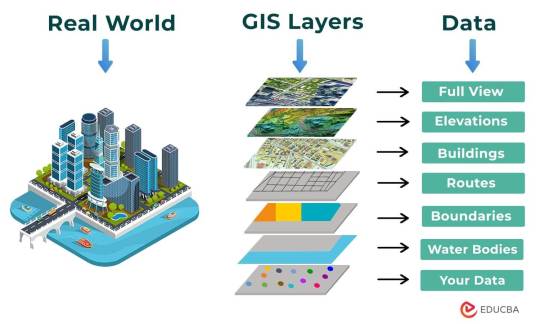
The following points elucidate the notable involvement of GIS in our daily lives:
Navigation and Location Services: GIS provides monitoring functions through the visual display of spatial data and precise geographical positioning of monitored vehicles, whereas GPS provides accurate, clear, and precise information on the position and navigation of a monitored or tracked vehicle in real-time and at the exact location.GIS is at the core of navigation applications and location-based services on smartphones. It enables accurate mapping, real-time navigation, and geolocation services, assisting individuals in finding locations, planning routes, and navigating unfamiliar areas.
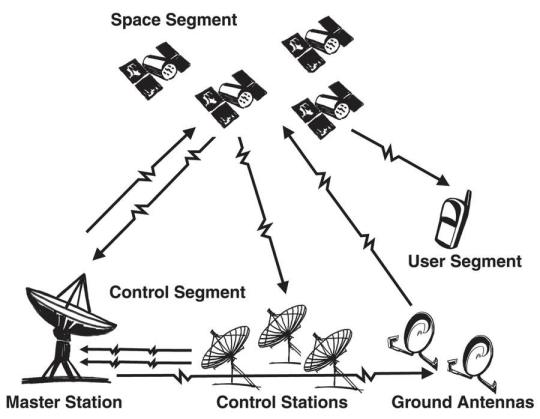
E-Commerce and Delivery Services: GIS software is a powerful tool for supply chain network planning. It helps determine the optimal location for distribution centers, warehouses, or other supply facilities. GIS is utilized in logistics and delivery services for optimizing routes, tracking shipments, and ensuring timely deliveries. E-commerce platforms leverage GIS to enhance the efficiency of their supply chain and last-mile delivery processes.

Weather Forecasting and Disaster Management: Many states are using GIS dashboard to monitor the rainfall across the state, on a real-time basis, from the data shared by rain sensors installed at various locationsGIS plays a crucial role in weather forecasting and disaster management. It assists meteorologists in analyzing spatial data, predicting weather patterns, and facilitating timely responses to natural disasters by mapping affected areas and coordinating emergency services.

Healthcare Planning and Disease Monitoring: Geographic Information Systems enable the visualization and monitoring of infectious diseases. Additionally GIS records and displays the necessary information that health care needs of the community as well as the available resources and materials. GIS supports public health initiatives by mapping the spread of diseases, analyzing healthcare resource distribution, and assisting in the planning of vaccination campaigns. It aids in identifying high-risk areas and optimizing healthcare service delivery.
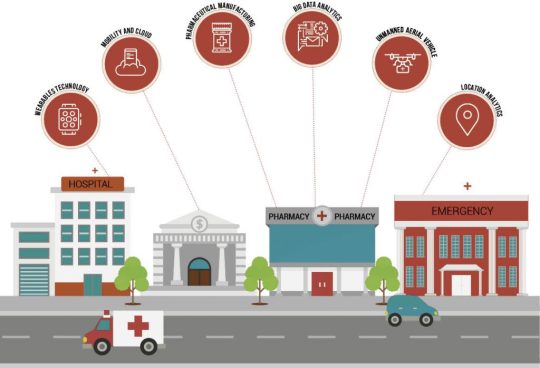
Social Media and Geo-tagging: GIS also helps in geotagging and other location related information in posts, it’s tools can map and visualize the spatial distribution of social media activity. This analysis can reveal trends, hotspots, and patterns in user engagement across different geographic areas. Many social media platforms incorporate GIS for geo-tagging, allowing users to share their location and experiences. This feature enhances social connectivity and facilitates the sharing of location-specific information.
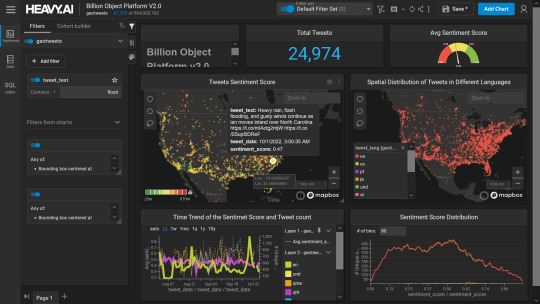
Smart City Initiatives: The Geographic Information System (GIS) offers advanced and user-friendly capabilities for Smart City projects and allows to capture, store and manipulate, analyze and visualize spatially referenced data. It is used for spatial analysis and modeling. It is the cornerstone of smart city planning, enabling the integration of data for efficient urban management. It supports initiatives related to traffic management, waste disposal, energy consumption, and overall infrastructure development.

Education and Research: GIS is increasingly utilized in education and research for visualizing and analyzing spatial data. It enables students and researchers to explore geographic relationships, conduct field studies, and enhance their understanding of various subjects.

Agricultural Management and Precision Farming: Farmers leverage GIS to optimize agricultural practices by analyzing soil conditions, crop health, and weather patterns. Precision farming techniques, facilitated by GIS, contribute to increased crop yields and sustainable farming practices.

Real Estate and Property Management: In the real estate sector, GIS aids in property mapping, land valuation, and site selection. It provides real estate professionals with valuable insights into spatial relationships, market trends, and optimal development opportunities.
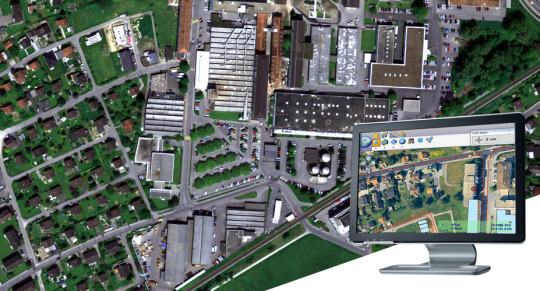
Tourism and Recreation: GIS enhances the tourism industry by providing interactive maps, route planning, and location-based information. It assists tourists in exploring destinations, finding attractions, and navigating efficiently.

The broad and varied involvement of GIS in our daily lives underscores its significance as a technology that not only facilitates geographic data analysis but also contributes to the efficiency, safety, and interconnectedness of modern society. As GIS applications continue to evolve, their impact on daily activities is expected to further expand and refine.
#gis#architectdesign#architecture#city#education#geographic information system(gis)#geographical indication
14 notes
·
View notes
Text
The hacker ecosystem in Russia, more than perhaps anywhere else in the world, has long blurred the lines between cybercrime, state-sponsored cyberwarfare, and espionage. Now an indictment of a group of Russian nationals and the takedown of their sprawling botnet offers the clearest example in years of how a single malware operation allegedly enabled hacking operations as varied as ransomware, wartime cyberattacks in Ukraine, and spying against foreign governments.
The US Department of Justice today announced criminal charges today against 16 individuals law enforcement authorities have linked to a malware operation known as DanaBot, which according to a complaint infected at least 300,000 machines around the world. The DOJ’s announcement of the charges describes the group as “Russia-based,” and names two of the suspects, Aleksandr Stepanov and Artem Aleksandrovich Kalinkin, as living in Novosibirsk, Russia. Five other suspects are named in the indictment, while another nine are identified only by their pseudonyms. In addition to those charges, the Justice Department says the Defense Criminal Investigative Service (DCIS)—a criminal investigation arm of the Department of Defense—carried out seizures of DanaBot infrastructure around the world, including in the US.
Aside from alleging how DanaBot was used in for-profit criminal hacking, the indictment also makes a rarer claim—it describes how a second variant of the malware it says was used in espionage against military, government, and NGO targets. “Pervasive malware like DanaBot harms hundreds of thousands of victims around the world, including sensitive military, diplomatic, and government entities, and causes many millions of dollars in losses,” US attorney Bill Essayli wrote in a statement.
Since 2018, DanaBot—described in the criminal complaint as “incredibly invasive malware”—has infected millions of computers around the world, initially as a banking trojan designed to steal directly from those PCs' owners with modular features designed for credit card and cryptocurrency theft. Because its creators allegedly sold it in an “affiliate” model that made it available to other hacker groups for $3,000 to $4,000 a month, however, it was soon used as a tool to install different forms of malware in a broad array of operations, including ransomware. Its targets, too, quickly spread from initial victims in Ukraine, Poland, Italy, Germany, Austria, and Australia to US and Canadian financial institutions, according to an analysis of the operation by cybersecurity firm Crowdstrike.
At one point in 2021, according to Crowdstrike, Danabot was used in a software supply-chain attack that hid the malware in a javascript coding tool called NPM with millions of weekly downloads. Crowdstrike found victims of that compromised tool across the financial service, transportation, technology, and media industries.
That scale and the wide variety of its criminal uses made DanaBot “a juggernaut of the e-crime landscape,” according to Selena Larson, a staff threat researcher at cybersecurity firm Proofpoint.
More uniquely, though, DanaBot has also been used at times for hacking campaigns that appear to be state-sponsored or linked to Russian government agency interests. In 2019 and 2020, it was used to target a handful of Western government officials in apparent espionage operations, according to the DOJ's indictment. According to Proofpoint, the malware in those instances was delivered in phishing messages that impersonated the Organization for Security and Cooperation in Europe and a Kazakhstan government entity.
Then, in the early weeks of Russia's full-scale invasion of Ukraine, which began in February 2022, DanaBot was used to install a distributed denial-of-service (DDoS) tool onto infected machines and launch attacks against the webmail server of the Ukrainian Ministry of Defense and National Security and Defense Council of Ukraine.
All of that makes DanaBot a particularly clear example of how cybercriminal malware has allegedly been adopted by Russian state hackers, Proofpoint's Larson says. “There have been a lot of suggestions historically of cybercriminal operators palling around with Russian government entities, but there hasn't been a lot of public reporting on these increasingly blurred lines,” says Larson. The case of DanaBot, she says, “is pretty notable, because it's public evidence of this overlap where we see e-crime tooling used for espionage purposes.”
In the criminal complaint, DCIS investigator Elliott Peterson—a former FBI agent known for his work on the investigation into the creators of the Mirai botnet—alleges that some members of the DanaBot operation were identified after they infected their own computers with the malware. Those infections may have been for the purposes of testing the trojan, or may have been accidental, according to Peterson. Either way, they resulted in identifying information about the alleged hackers ending up on DanaBot infrastructure that DCIS later seized. “The inadvertent infections often resulted in sensitive and compromising data being stolen from the actor's computer by the malware and stored on DanaBot servers, including data that helped identify members of the DanaBot organization,” Peterson writes.
The operators of DanaBot remain at large, but the takedown of a large-scale tool in so many forms of Russian-origin hacking—both state-sponsored and criminal—represents a significant milestone, says Adam Meyers, who leads threat intelligence research at Crowdstrike.
“Every time you disrupt a multiyear operation, you're impacting their ability to monetize it. It also creates a bit of a vacuum, and somebody else is going to step up and take that place,” Meyers says. “But the more we can disrupt them, the more we keep them on their back heels. We should rinse and repeat and go find the next target.”
4 notes
·
View notes
Text
Best Business Software Tools in 2024
The right software tools can help increase productivity, draft operations more efficiently and promote company growth in today's high-paced business environment. Whether you are a start-up or an existing enterprise the following business software is necessary to improve different areas of your business.
1. Project Management: ClickUp
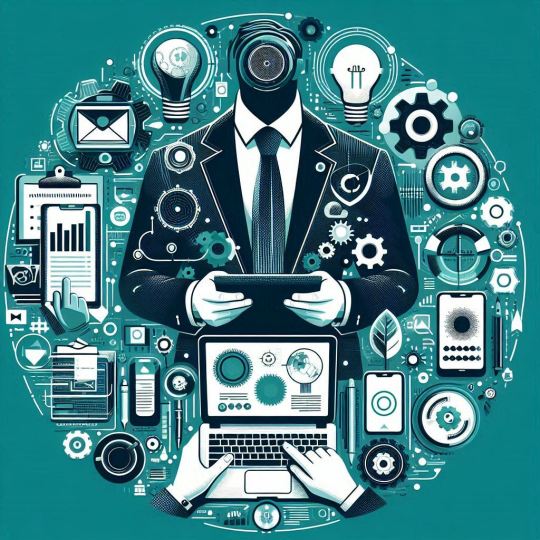
It is a feature-laden project manager that lets you handle tasks, projects, and workflows of all types. Its ease of use and user-friendly interface, complimented with diverse dashboards cater to audiences between small teams and large organizations. Task assignments, time tracking, goal setting, and collaboration options allow you to stop hopping between spreadsheets and emails so your projects are complete efficiently.
2. CRM–– Zoho CRM
Zoho CRM — Your Intelligent Customer Relationships Management System. Among other features, it has lead management, sales automation, and analytics to make sales performance improve on a consistent streamline both administrative aspect as well as customer satisfaction. Due to its integration capabilities with other Zoho products, as well as most third-party applications, It has become a flexible option for businesses that are ready to supercharge their customer relationship management.
3. Accounting: Zoho Books

Zoho Books- The Best Accounting Software for Business Owners Invoicing, expense tracking and financial reporting are some of its features. You can also rest assured that your taxes are being handled correctly and always have the latest view of your financial health to help you manage your finances better.
4. HR Management: monday. com HR
It is a complete human resources management software that helps companies to better structure their workforce. This system provides with facilities like employee on boarding, performance tracking, payroll management etc. With the platform's ease of use, UI simplicity, and automation capabilities in HR processes that would otherwise take hours away from key HR initiatives.
5. Payroll: OnPay

OnPay is an excellent payroll software for businesses of all sizes. It is a cloud payroll software for businesses that ensures complete compliance and automation of top-class payroll calculations, tax filings & employee payments. Additionally, OnPay provides HR and benefits management tools, effectively providing a full-fledged employee pay management solution.
6. Point-of-Sale (POS): eHopper
Versatile Point of Sale Software for Businesses Up To Mid-Sized It offers services like Inventory management, sales tracking and customer management. This makes eHopper a perfect choice for businesses that intend to simplify their sales operations using an affordable and intuitive POS system.
7. Inventory Management: Cin7
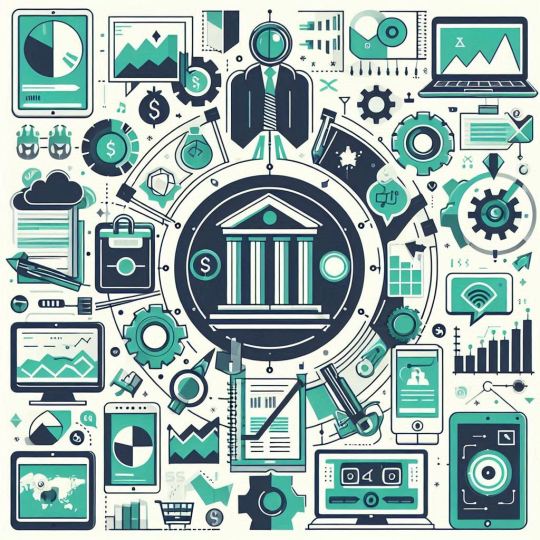
While there are plenty of other inventory management systems available, Cin7 stands out as one of the most popular options for small to mid-size businesses (SMBs) looking to get their stock levels, orders and supply chain operations under control. These functionalities consist of real-time inventory monitoring, order processing and e-commerce platform integration. With the powerful feature set of Cin7, businesses can keep inventory at an optimal level and fulfill customer demands to the hilt.
8. Website Builder: Weebly
Weebly is the website builder that you can also use to build your site or blog. It has lots of customizable templates, drag-and-drop functionality, and e-commerce ready to go. With Weebly, you can create a professional website even if you are a tech noob and give your business the relevant online visibility it needs.
9. Recruiting: ZipRecruiter

ZipRecruiter: Popular rated job search app for businesses on board. They provide hiring solutions through features like job posting candidates filtering and tracking the application. AI-powered matching from ZipRecruiter surfaces more relevant candidates to businesses faster.
10. VPN: NordVPN
It is a secure, encrypted VPN application that will make sure that you and your business stay safe as you work with the web. It provides features of encrypted connections, threat protection and global server access as well. In this way, It guarantees secure data in companies and privacy on internet.
Conclusion
The business software tools a company uses are very important to increase productivity and power growth. The above-mentioned tools are some of the best & flexible according to the fact which can assist businesses for any sized groups and help them attain their desired objectives. Implementing these tools in your operations can also help speed up processes and lead to higher customer satisfaction, as well as allow you to be on top of the competition.
#business#business growth#innovation#startup#entrepreneur#100 days of productivity#project management#sales#payroll#hr management#hr software#hr services#ai#artificial intelligence#technology#tech#techinnovation
3 notes
·
View notes
Text
Organizations Market Insights: 7 Game-Changing Innovations to Watch

Explosive Market Growth Driven by Institutional Demand and B2B Innovation
The global organizations market is entering a transformative phase, with projections estimating a surge from USD 7.19 billion in 2022 to over USD 1,374.15 billion by 2031, registering a CAGR of 35.5% from 2024 to 2031. This rapid ascent is propelled by the rising demand across public, private, and non-profit sectors for comprehensive operational solutions, digitization, and long-term service integrations.
This organizations market encompasses a diverse array of business-to-business (B2B) interactions, with organizations procuring vast volumes of goods and services essential for internal functions and external service delivery. The key distinguishing feature of this sector is its emphasis on value-driven procurement, strategic supplier relationships, and multi-layered decision-making structures.
Request Sample Report PDF (including TOC, Graphs & Tables): https://www.statsandresearch.com/request-sample/40468-global-organizations-market
Organizations Market Segmentation: Diverse Needs, Unified Demand
By Organizational Type
Private Sector
Organizations in this segment prioritize return on investment, agility, and innovation. Tech firms, manufacturers, and service providers drive procurement, investing in automation tools, logistics, enterprise software, and cybersecurity solutions.
Public Sector
Governments at all levels invest in infrastructure modernization, citizen services, and digital governance, acquiring long-term solutions in healthcare, education, defense, and transportation.
Non-Profit Sector
Focused on mission delivery over profit, these organizations allocate budgets toward solutions that enhance social impact, such as community management systems, sustainability technologies, and donor engagement platforms.
Get up to 30%-40% Discount: https://www.statsandresearch.com/check-discount/40468-global-organizations-market
By Product and Services
Raw Materials: Core components like chemicals, metals, and polymers that feed manufacturing and construction.
Finished Goods: Includes machinery, IT hardware, medical devices, and other end-use assets.
Durable Goods: Vehicles, production machinery, and infrastructure components.
Consumables: Everyday operational inputs—paper, lab reagents, medical disposables.
Service Verticals:
Consulting: Strategic and operational optimization across sectors.
IT Services: Digital transformation, cybersecurity, cloud infrastructure, SaaS.
Maintenance and Support: Preventive servicing and troubleshooting to maximize uptime.
Training and Education: Skill enhancement aligned with emerging tech and regulatory requirements.
Sector-Specific Applications: Customization at Scale
Healthcare
Technology is redefining patient engagement, diagnostics, and operational workflows. Investments in Electronic Health Records (EHRs), medical IoT devices, and AI-powered diagnostic tools are pivotal.
Education
Demand for Learning Management Systems (LMS), virtual classrooms, and administrative software is intensifying as institutions modernize and scale their operations globally.
Finance
Financial organizations are deploying advanced analytics, fraud detection systems, and compliance engines to manage increasingly complex portfolios and regulatory landscapes.
Manufacturing
Driven by Industry 4.0, manufacturers are integrating MES systems, automation robotics, supply chain monitoring, and predictive maintenance platforms.
End-User Landscape: Decision-Making Dynamics and Tailored Solutions
Enterprises
Large-scale operations demand integrated ecosystems—ERP, CRM, HRM systems, and IoT networks—all with cross-border functionality and data analytics capabilities.
Small and Medium Businesses (SMBs)
Cost-effective, scalable solutions are paramount. Cloud-based services, modular ERP systems, and affordable IT support are highly sought-after.
Government Agencies
Prioritizing transparency, efficiency, and citizen-centric services, agencies procure enterprise-grade digital infrastructure, secure data platforms, and AI governance tools.
Educational Institutions
A shift towards smart campuses and digitized learning ecosystems is catalyzing demand for IT infrastructure, real-time student tracking systems, and data-driven learning analytics.
Competitive Ecosystem: Leaders Shaping Organizational Digitization
Prominent players are pioneering the evolution of the organizations market, leveraging robust product portfolios, cloud ecosystems, and international presence. These include:
IBM – Cognitive business and AI-driven transformation.
Microsoft – Cloud-first enterprise solutions and productivity software.
Oracle – Database systems and ERP platforms.
SAP – Business process optimization and automation.
Salesforce – CRM innovation and customer experience platforms.
Dell Inc. – Scalable IT infrastructure.
Cisco Systems, Inc. – Networking and security.
Amazon Web Services (AWS) – Cloud computing and AI services.
Accenture – Strategy consulting and digital execution.
Hewlett Packard Enterprise (HPE) – Edge-to-cloud platforms and intelligent edge.
These firms, alongside emerging disruptors, are aggressively competing through innovation, ecosystem partnerships, and vertical-specific customizations.
Regional Organizations Market Dynamics: Global Influence, Local Adaptation
North America
Characterized by early technology adoption and mature infrastructure, with the U.S. leading government digitization, cloud migration, and enterprise IT transformation.
Asia-Pacific
Rapid industrial growth and digital inclusion initiatives in China, India, Japan, and ASEAN nations are catalyzing exponential market expansion.
Europe
Focus on compliance, sustainable procurement, and smart public services underpins robust demand in Germany, UK, France, and Italy.
Middle East & Africa
Smart city initiatives and public-private partnerships are pivotal to regional growth, particularly in the GCC nations.
South America
Increasing investments in public services and education, notably in Brazil, are enhancing the role of digital solutions in regional development.
Organizations Market Forecast Through 2031
This growth trajectory reflects the unprecedented convergence of digital transformation, globalization of service procurement, and institutional modernization. Procurement behavior is increasingly favoring long-term contracts, as-a-service models, and modular solution architectures, facilitating both adaptability and ROI.
Strategic Imperatives for Organizations Market Participants
Vertical Specialization: Offer sector-specific configurations for healthcare, finance, manufacturing, and public services.
Sustainability Integration: Align procurement solutions with ESG goals and circular economy practices.
AI and Automation: Deploy intelligent systems that reduce human error and increase operational speed.
Cloud and Edge Synergy: Combine the scalability of cloud with the real-time benefits of edge computing.
Cybersecurity First: Integrate zero-trust security architecture from procurement to deployment.
Purchase Exclusive Report: https://www.statsandresearch.com/enquire-before/40468-global-organizations-market
Conclusion: The Future of Organizational Procurement
The organizations market is on an unrelenting growth trajectory, reshaping how institutions across sectors and regions invest in infrastructure, services, and digital tools. To remain competitive, stakeholders must embrace tailored innovation, ecosystem integration, and client-centric strategies. The era of reactive procurement is over—strategic, proactive, and data-driven engagement defines the future of organizational marketplaces.
Our Services:
On-Demand Reports: https://www.statsandresearch.com/on-demand-reports
Subscription Plans: https://www.statsandresearch.com/subscription-plans
Consulting Services: https://www.statsandresearch.com/consulting-services
ESG Solutions: https://www.statsandresearch.com/esg-solutions
Contact Us:
Stats and Research
Email: [email protected]
Phone: +91 8530698844
Website: https://www.statsandresearch.com
1 note
·
View note
Text
How to Choose the Best ERP for Engineering and Manufacturing Industry
In today’s fast-paced world, engineering and manufacturing companies face increasing pressure to deliver high-quality products while maintaining efficiency and cost-effectiveness. Implementing the right Enterprise Resource Planning (ERP) software can significantly enhance operations, streamline workflows, and boost productivity. However, with numerous options available, selecting the best ERP software for the engineering and manufacturing industry can be challenging. This guide will help you navigate this decision-making process and choose the most suitable solution for your business.
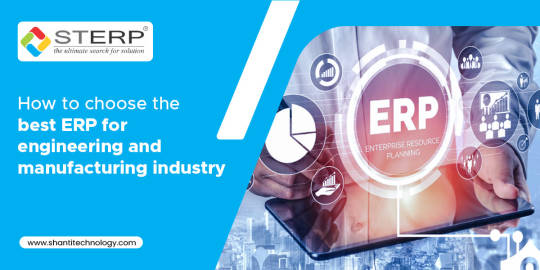
Why ERP is Crucial for Engineering and Manufacturing
ERP software integrates various business processes, including production, inventory management, supply chain, finance, and human resources. For engineering and manufacturing companies, ERP solutions are particularly vital because they:
Facilitate real-time data sharing across departments.
Enhance supply chain management.
Optimize production planning and scheduling.
Ensure compliance with industry standards.
Reduce operational costs.
Partnering with the right Engineering ERP software company ensures that your organization leverages these benefits to stay competitive in a dynamic market.
Steps to Choose the Best ERP for Engineering and Manufacturing
1. Understand Your Business Needs
Before exploring ERP solutions, evaluate your company’s specific requirements. Identify the pain points in your current processes and prioritize the features you need in an ERP system. Common features for engineering and manufacturing companies include:
Bill of Materials (BOM) management
Production planning and scheduling
Inventory control
Quality management
Financial reporting
Consulting with a reputed ERP software company can help you match your needs with the right features.
2. Look for Industry-Specific Solutions
Generic ERP software might not address the unique needs of the engineering and manufacturing sector. Opt for an ERP software in India that offers modules tailored to your industry. Such solutions are designed to handle specific challenges like multi-level BOM, project costing, and shop floor management.
3. Check Vendor Expertise
Choosing a reliable vendor is as important as selecting the software itself. Research ERP solution providers with a strong track record in serving engineering and manufacturing companies. Look for reviews, case studies, and client testimonials to gauge their expertise.
4. Evaluate Scalability and Flexibility
Your business will grow, and so will your operational requirements. Ensure that the ERP system you choose is scalable and flexible enough to accommodate future needs. The top 10 ERP software providers in India offer scalable solutions that can adapt to changing business demands.
5. Assess Integration Capabilities
An ERP system must integrate seamlessly with your existing tools, such as Computer-Aided Design (CAD) software, Customer Relationship Management (CRM) systems, and IoT devices. A well-integrated system reduces redundancies and enhances efficiency.
6. Prioritize User-Friendliness
A complex system with a steep learning curve can hinder adoption. Choose an ERP software with an intuitive interface and easy navigation. This ensures that your employees can use the system effectively without extensive training.
7. Consider Customization Options
No two businesses are alike. While standard ERP solutions offer core functionalities, some companies require customization to align with specific workflows. A trusted ERP software company in India can provide custom modules tailored to your unique needs.
8. Focus on Data Security
Engineering and manufacturing companies often deal with sensitive data. Ensure that the ERP solution complies with the latest security standards and offers robust data protection features.
9. Compare Pricing and ROI
While cost is an important factor, it should not be the sole criterion. Evaluate the long-term return on investment (ROI) offered by different ERP software. A slightly expensive but feature-rich solution from the best ERP software provider in India may deliver better value than a cheaper alternative with limited functionalities.
10. Test Before You Commit
Most ERP software companies offer free trials or demo versions. Use these opportunities to test the software in a real-world scenario. Gather feedback from your team and ensure the solution meets your expectations before finalizing your decision.
Benefits of Partnering with the Best ERP Software Providers in India
India is home to some of the leading ERP software providers in India, offering state-of-the-art solutions for the engineering and manufacturing sector. Partnering with a reputable provider ensures:
Access to advanced features tailored to your industry.
Reliable customer support.
Comprehensive training and implementation services.
Regular updates and enhancements to the software.
Companies like Shantitechnology (STERP) specialize in delivering cutting-edge ERP solutions that cater specifically to engineering and manufacturing businesses. With years of expertise, they rank among the top 10 ERP software providers in India, ensuring seamless integration and exceptional performance.
Conclusion
Selecting the right ERP software is a critical decision that can impact your company’s efficiency, productivity, and profitability. By understanding your requirements, researching vendors, and prioritizing features like scalability, integration, and security, you can find the perfect ERP solution for your engineering or manufacturing business.
If you are looking for a trusted ERP software company in India, consider partnering with a provider like STERP. As one of the best ERP software providers in India, STERP offers comprehensive solutions tailored to the unique needs of engineering and manufacturing companies. With their expertise, you can streamline your operations, improve decision-making, and stay ahead in a competitive market.
Get in touch with STERP – the leading Engineering ERP software company – to transform your business with a reliable and efficient ERP system. Take the first step toward a smarter, more connected future today!
#Manufacturing ERP software company#ERP solution provider#Engineering ERP software company#ERP software company#ERP software companies
6 notes
·
View notes